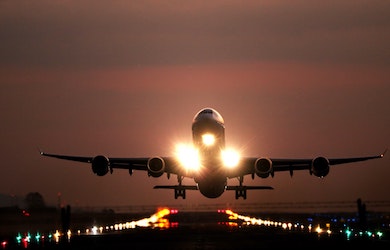Background
The State Action Plan on CO2 Aviation Emissions Reduction was launched in 2010 by the International Civil Aviation Organisation (ICAO). Its aim was to encourage all ICAO Member States to establish a long-term strategy on climate change for the international aviation sector, with the involvement of all interested parties at the national level. Since the launch, the initiative has been one of the most successful programmes with ICAO Member States.
Figure 1: La Palma – Brena Baja-Mazo – Airport[3]
Global Aspirational Goals for the Aviation Sector
As of 8th October 2020, 119 States have submitted their State Action Plans to ICAO, which represents 97.39% of global international aviation traffic in revenue tonne-kilometres (RTK). These parties are encouraged to work together for the purpose of:
- Defining a quantified baseline emissions scenario;
- Selecting appropriate emissions mitigation measures from ICAO’s basket of measures;
- Calculating the expected results of implementing those selected measures.
The level of detail and quantified information submitted within a State Action Plan facilitates ICAO’s assessment of the global progress towards meeting the two global aspirational goals for the international aviation sector, these are:
- 2% annual fuel efficiency improvement through 2050.
- Carbon-neutral growth from 2020 onwards.[1]
Guidance Provided for the Member States
To assist the 193 Member States with their State Action Plans, ICAO has developed various forms of tools and quantification tools.
The tools so far include:
- An ICAO Carbon Emissions Calculator;
- A free online course in cooperation with the United Nations Institute for Training and Research (UNITAR);
- Regional workshops and seminars on State Action Plans.
For the continuous success of the ICAO State Action Plans initiative, a substantial involvement and cooperation of both States and other stakeholders is needed to provide quantified and qualified input. This is a continual process to ensure that State Action Plans are updated and reflective of the States’ situation and future planning. Currently the State Action Plans are required to be updated by each State every three years (source: see Reference 1).
Achieving Net CO2 Emissions
For the State Action Plans to be effective in considering the global aspirations of the international aviation sector, resources and funds are required to meet the targets set out by ICAO. Reported by ICAO Environment, Fleming and Lepinay advised of the requirements for the success of net CO2 emissions scenario, including the highest levels of:
- Agricultural productivity;
- Availability of land for feedstock cultivation;
- Residue removal rates;
- Conversion efficiency improvements.
It would also require a strong market or policy emphasis on bioenergy, and alternative aviation fuel, which implies that a large share of the globally available bioenergy resource would be devoted to producing aviation fuel.[2]
What Should be Done in the Future?
The role of the State Action Plans should be enhanced further, by including forward-looking mitigation measures available to States based on latest and future environment-driven technology and innovations. These include renewable energy, new sustainable aviation fuels, and more low carbon energy sources.
About Pager Power
Pager Power has expertise in helping wind developers assess impacts of both offshore and onshore wind farms for aviation, telecommunications, and supporting developers through the planning process by assisting with the engagement of stakeholders. For more information about what we do, please get in touch.
References
[1] Hupe, J. (October 2020), The 10th Anniversary of the ICAO State Action Plan on CO2 Emissions Reduction, (https://unitingaviation.com/news/environment/icao-state-action-plan-on-co2-emissions-reduction-10th-anniversary/) Uniting Aviation [Accessed: October 2020).
[2] Fleming, G and Lepinay, I. (Published: 2020), 2019 Environmental Report, (https://www.icao.int/environmental-protection/Pages/envrep2019.aspx) ICAO Environment [Accessed: October 2020].
[3] https://commons.wikimedia.org/wiki/File:La_Palma_-_Brena_Baja-Mazo_-_Airport_(Mirador_del_Aeropuerto)_06_ies.jpg , Author: Frank Vincentz, date: 24/03/2015. [Accessed: October 2020].




